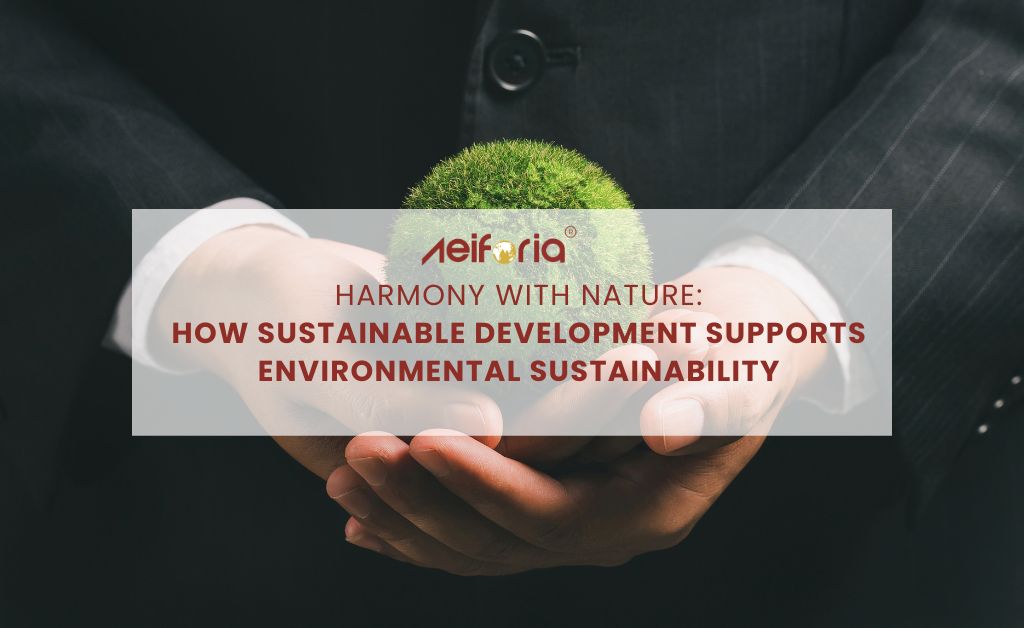
How Sustainable Development Helps in Environmental Sustainability
In an era characterized by rapid industrialization, urbanization, and population growth, the pursuit of sustainable development has become imperative for the well-being of our planet.
Sustainable development, a concept that has gained increasing recognition in recent decades, serves as a beacon of hope for a more environmentally sustainable future.
This blog post will examine the profound connections between sustainable development and environmental sustainability and how they can address our planet's pressing issues.
Defining Sustainable Development
Let's define these terms before delving into the relationship between sustainable development and environmental sustainability.
Sustainable Development: Sustainable development is about fulfilling our current needs without hurting the ability of future generations to meet their own needs. It is achieved through balanced and equitable growth of society. It encompasses economic, social, and environmental aspects, aiming to improve everyone's quality of life without harming the planet.
Environmental Sustainability: Environmental sustainability, on the other hand, focuses specifically on maintaining the health of the Earth's ecosystems and the well-being of all species that inhabit it, including humans. It involves conserving natural resources, reducing pollution, and safeguarding biodiversity.
The Interdependence of Sustainable Development and Environmental Sustainability
- Resource Management: Sustainable development places a strong emphasis on responsible resource management. By utilizing resources efficiently and conserving them for future generations, we reduce the over-exploitation of natural resources, a significant driver of environmental degradation. This approach ensures that the planet's resources, such as freshwater, forests, and minerals, remain available for the long term.
- Renewable Energy: A crucial aspect of sustainable development is the promotion of renewable energy sources like wind, solar, and hydroelectric power. By shifting from fossil fuels to clean energy alternatives, we reduce greenhouse gas emissions and combat climate change, a primary environmental concern. This transition is a cornerstone of sustainable development and is pivotal for preserving the environment.
- Biodiversity Conservation: Sustainable development recognizes the importance of biodiversity and ecosystem services. Sustainable development contributes to ecosystems' overall health and resilience by protecting and restoring natural habitats and supporting initiatives that conserve endangered species. A diverse and thriving ecosystem is vital for both environmental and human well-being.
- Waste Reduction and Recycling: Sustainable development encourages waste reduction and recycling, which minimizes the environmental impact of landfills and incineration. Less waste in landfills means less pollution of soil and groundwater, reducing the harm done to the environment. Recycling and reusing materials also decreases the need for new resource extraction.
- Social Equity: A fundamental principle of sustainable development is social equity, ensuring that the benefits of development are shared among all members of society. Environmental sustainability is closely linked to social well-being. Sustainable development can reduce environmental pressures by addressing social issues like poverty and inequality, as social stability often leads to more responsible resource management.
- Climate Action: Sustainable development aligns with global climate action goals. Initiatives that promote sustainable transportation, energy efficiency, and carbon reduction directly contribute to environmental sustainability by mitigating the effects of climate change. Addressing climate change is critical for safeguarding the environment and future generations.
- Sanitation and Clean Water: Water and sanitation are crucial for sustainable development. It is essential to ensure that all communities have access to clean water to preserve aquatic ecosystems and protect human health. This contributes to society's and the environment's well-being, creating a win-win situation.
Also Read: Why Should We Use Renewable Energy Resources
The Role of International Agreements
The global community has admitted the importance of sustainable development and environmental sustainability through international agreements and frameworks.
The United Nations Sustainable Development Goals (SDGs) are a prime example of this commitment. The SDGs address many issues, from poverty eradication to climate action, directly or indirectly impacting environmental sustainability.
By committing to these goals, nations collaborate to establish a sustainable and environmentally conscious world.
Challenges on the Path to Environmental Sustainability
Despite the profound connection between sustainable development and environmental sustainability, some challenges hinder progress. One major challenge is short-term thinking and immediate economic pressures, which can lead to unsustainable practices that harm the environment in the long run.
Additionally, vested interests in industries that rely on unsustainable practices can resist change, making it difficult to transition to more environmentally friendly alternatives.
To overcome these challenges, we must change our thoughts, policies, and actions. Sustainable development offers a framework for making this transition, promoting the well-being of current and future generations while safeguarding the environment.
Conclusion
Sustainable development is not just a buzzword; it's a powerful concept that offers a comprehensive approach to addressing the world's most pressing issues. By integrating economic, social, and environmental aspects, sustainable development provides a roadmap for achieving environmental sustainability.
The interdependence of these two concepts is clear: environmental sustainability is a crucial element of sustainable development, and sustainable development is vital for achieving environmental sustainability.
The road to environmental sustainability is undoubtedly challenging. Still, it is a path we must travel for our planet and future generations.
Sustainable development is our guide, offering a more harmonious and balanced world where economic growth and social well-being coexist with a healthy and vibrant environment. It is a vision worth pursuing, which promises a brighter, more sustainable future for all.
Frequently Asked Questions (FAQs)
What's the primary goal of sustainable development for the environment?
The primary objective of sustainable development is to encourage the long-term health and viability of the environment while ensuring that human activities do not cause harm.
How does sustainable urban planning promote environmental sustainability?
Sustainable urban planning focuses on reducing pollution, improving public transportation, and creating green spaces, all of which enhance environmental sustainability in cities.
Why is biodiversity important within the context of sustainable development?
Biodiversity is essential for ecosystem stability and resilience. Sustainable development aims to protect and restore biodiversity as it contributes to overall environmental health.
Can businesses benefit from sustainable practices related to environmental sustainability?
Yes, businesses can benefit from sustainability through cost savings, improved reputation, and access to environmentally conscious markets. Sustainable practices can be profitable.
What's the role of education in advancing sustainable development for environmental sustainability?
Education raises awareness about environmental issues and encourages informed decision-making. It empowers individuals and communities to take actions that support environmental sustainability.






